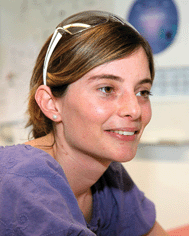Clémence Corminboeuf
Interview by Carey Sargent, EPFL, NCCR MARVEL
The biggest challenge that woman scientists face is…
I used to say that it’s finding a good time to have children (if you want some), but now that I am a bit older, a posteriori, I think it’s more understanding that there’s no bad time to have children. Of course, you don’t know this early on. You cogitate, okay, when is the good time and you worry, because it is a very demanding career, but actually there’s no bad time—I prefer to say that then there is no good time. At the end of it, I think we are superheroes, and this is something that becomes very clear when you have kids.
Solving the dual career issue (the “two-body” problem, as a quantum chemist would say) was also a big puzzle for me. Switzerland is very much behind in this respect and our academic system has zero mechanism aiming to facilitate the life of scientific couples.
It is obvious that most woman scientists will meet their spouse at work (because we work so much). If the Swiss Institutions (and the SNF) want to attract and retain more women, they will need to take better care of their supportive partners.

I chose a scientific career because…
The question I asked myself was more specific, actually, it was which science—would I choose physics or chemistry? And I though physicists were weird, so I chose chemistry. I think though that I always wanted to do science. I cannot remember a time that I was not interested in science and so it came very naturally, I just had to decide which one. I picked chemistry because of my ideas about physicists – I wasn’t very mature at the time!
If I were not a scientist, I would be…
Frustrated! I think it’s kind of a luxury to be a scientist and I think I would be frustrated if I weren’t one.
My most exciting MARVEL discovery to date has been…
The most exciting MARVEL discovery to date came from the true collaboration that I had with several people within the network. For instance, the machine learning models of the electron density with the group of Michele Ceriotti that resulted in a very general approach to predict any scalar field. It is also thanks to MARVEL that we launched our catalysis effort, which had involved many collaborations (e.g., with Anatole von Lilienfeld) and has since then, become a separated large-scale project. Overall, MARVEL played a key role into transforming my classical disciplinary research group into a much more diverse team of scientists with expertise in fields of quantum chemistry, molecular dynamic simulations, machine learning algorithms, data science, computational catalysis that enable us to tackle bigger challenges.
My top two papers are...
In terms of MARVEL papers, the Chemical Science with Anatole von Lilienfeld “Machine learning meets volcano plots: computational discovery of cross-coupling catalysts” and the Chemical Science “Electron Density Learning of Non-Covalent Systems” with Michele Ceriotti. Again, these are the top two papers, I would pick in a MARVEL context not only because of the associated synergy but also because they are really great examples of cutting edged innovations in the field of machine learning applied to quantum chemistry problems.
